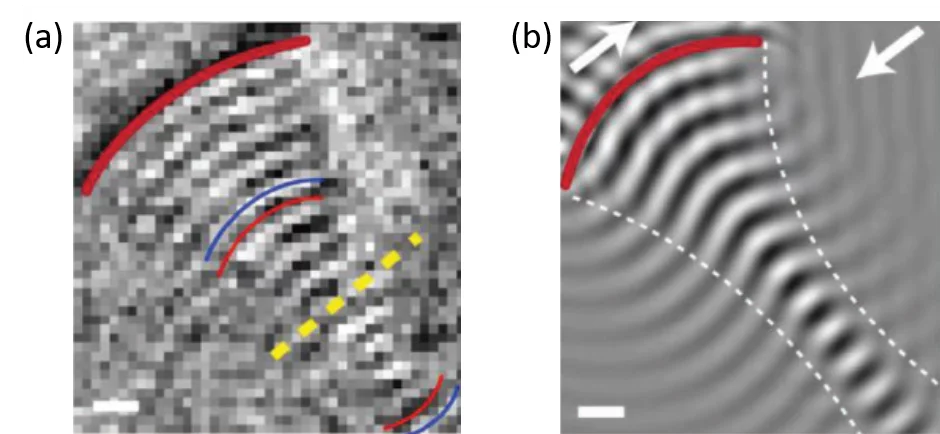Magnons, or spin waves, are the magnetic counterpart of electromagnetic radiation. Such waves describe propagating disturbances in the local magnetization of ferromagnetic materials. While there are many similarities with their electromagnetic counterparts, spin waves exhibit a set of properties, starting from a much smaller wavelength with respect to electromagnetic waves (at the same frequency) that make them of extreme interest for novel computing applications. In particular, their smaller wavelength is very promising for fostering a further miniaturization of computing devices.
Similarly to electromagnetic waves, magnons require a way to generate them (i.e. a magnonic “antenna”), a medium to propagate in, a way to manipulate them (i.e. perform “optical” operations such as focusing, interference, etc.), and a way to detect them. Given the nature of spin waves, all of these processes are extremely complex.
In the work described in this highlight, now published as the front cover article in the March 5th issue of Advanced Materials, a collaboration between Italian (Politecnico di Milano, CNR-IOM, and the University of Perugia), American (New York University), and Swiss (Swiss Light Source) institutes has been able to demonstrate a first prototype of a novel type of spin-wave generators, dubbed magnonic nanoantennas. Through these nanoantennas, it is possible not only to generate the propagating spin waves, but also to control their shape and propagation, e.g. through the generation of radial or planar wavefronts. Moreover, the shape of these nanoantennas can be modified in-situ by the application of external magnetic fields to focus the generated wavefronts, providing a versatility otherwise impossible to attain with the standard nanopatterned spin wave generators. Furthermore, by using multiple nanoantennas simultaneously, the researchers were able to generate on-demand interference patterns, which open the way for analog computing applications.
The nanoantennas were fabricated using a technique, called TAM-SPL, developed at the Politecnico di Milano in collaboration with Riedo’s group (New York University), which allows for the manipulation of the magnetic properties of a thin ferromagnetic film by modulating its interaction (exchange bias) with an antiferromagnetic material grown on top of it.
The visualization of the spin wave generation, propagation, and manipulation was made possible by the unique possibilities offered by the scanning transmission X-ray microscope installed at the PolLux beamline of the Swiss Light Source. The researchers employed an imaging technique called pump-probe imaging, which the PolLux endstation of the Swiss Light Source specializes in, to generate videos of the spin-wave dynamics where each successive frame is separated by a few hundred ps.
With these results, a new methodology for the generation and manipulation of magnons was demonstrated, and a new milestone in the road towards the development of magnonic nano-processors has been crossed.
Contacts:
Dr. Jörg Raabe
Swiss Light Source
Paul Scherrer Institut
Telephone: +41 56 310 5193
E-mail: joerg.raabe@psi.ch
Dr. Edoardo Albisetti
Dipartimento di Fisica
Politecnico di Milano
Telephone: +39 02 2399 9659
E-mail: edoardo.albisetti@polimi.it
Prof. Daniela Petti
Dipartimento di Fisica
Politecnico di Milano
Telephone: +39 02 2399 9660
E-mail: daniela.petti@polimi.it
Original Publication:
Optically Inspired Nanomagnonics with Nonreciprocal Spin Waves in Synthetic Antiferromagnets
Edoardo Albisetti, Silvia Tacchi, Raffaele Silvani, Giuseppe Scaramuzzi, Simone Finizio, Sebastian Wintz, Christian Rinaldi, Matteo Cantoni, Jörg Raabe, Giovanni Carlotti, Riccardo Bertacco, Elisa Riedo, and Daniela Petti
Advanced Materials 32, 1906439 (2020)
DOI: 10.1002/adma.201906439
Other Media:
Original press release at the Politecnico di Milano (in Italian):
https://www.polimi.it/fileadmin/user_upload/comunicati_stampa/1583417291_CS_SWING.pdf
